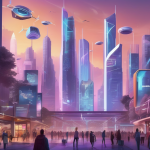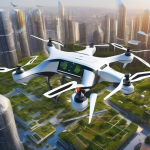The Future of AI-Powered Translation Technologies

In today’s fast-paced, interconnected world, the way we communicate is undergoing a profound transformation. AI-powered translation technologies are at the forefront of this revolution, breaking down language barriers and fostering global collaboration. Imagine being able to converse with someone halfway across the globe, speaking entirely different languages, yet feeling as if you’re having a face-to-face chat. This is not just a dream; it’s becoming a reality thanks to advancements in artificial intelligence.
The journey of translation technologies has been fascinating. From the early days of rudimentary machine translation systems that often produced nonsensical outputs, we’ve now arrived at sophisticated algorithms capable of understanding context, idioms, and cultural nuances. This evolution has not only improved the accuracy of translations but has also made them more relatable and human-like. Just think about it: a few decades ago, the idea of a computer translating languages in real-time seemed far-fetched. Now, it’s an everyday occurrence!
As we dive deeper into the realm of AI translation, it’s essential to recognize the current tools leading the charge. Many businesses and individuals are leveraging these technologies to enhance communication. The rise of Neural Machine Translation (NMT) has been particularly noteworthy. NMT utilizes deep learning to produce translations that are not only accurate but also fluent and natural. It’s like having a personal translator who understands not just the words, but the essence of what you want to convey.
However, as we embrace these advancements, we must also consider the challenges that come with them. Issues like data privacy, the need for extensive training datasets, and the complexities of translating less common languages are hurdles that the industry must overcome. But with continuous innovation and user feedback, the future of AI-powered translation looks incredibly promising.
In conclusion, as we stand at the brink of a new era in communication, the implications of AI translation technologies are vast. They not only enhance our ability to connect but also open doors to opportunities that were once unimaginable. The future is bright, and the possibilities are endless!
The Evolution of Translation Technologies
The journey of translation technologies has been nothing short of remarkable. From the rudimentary beginnings of machine translation systems in the 1950s to the sophisticated AI algorithms we see today, the evolution reflects our relentless pursuit of breaking down language barriers. Initially, translation was a laborious task, often requiring human intervention to ensure accuracy. Early systems, like the Georgetown-IBM experiment, laid the groundwork, showcasing the potential of machines to translate simple phrases.
As technology advanced, so did the complexity of translation tasks. The introduction of rule-based systems in the 1980s allowed for more structured translations but still struggled with nuances and context. Fast forward to the 1990s, and we saw the rise of statistical machine translation, which utilized vast databases of bilingual text to improve accuracy. This era was significant because it marked a shift from rigid rules to data-driven approaches, allowing machines to learn from real-world usage.
Today, we stand at the forefront of a new era with the advent of Neural Machine Translation (NMT). This technology employs deep learning techniques, enabling machines to produce translations that are not only accurate but also contextually relevant. NMT systems analyze entire sentences rather than individual words, resulting in translations that flow more naturally, much like human speech. However, this leap forward doesn’t come without its challenges, such as the need for extensive training data and concerns regarding data privacy.
In summary, the evolution of translation technologies has transitioned from simple machine translations to complex AI-driven systems. This transformation is not just about improving accuracy; it’s about enhancing communication across cultures and languages, paving the way for a more interconnected world. As we look ahead, the potential for further advancements in translation technologies is exciting, promising even greater breakthroughs in how we understand and interact with one another.
Current AI Translation Tools
In today’s fast-paced digital landscape, AI translation tools are revolutionizing the way we communicate across languages. These tools have come a long way from the clunky, error-prone systems of the past. Now, they utilize advanced algorithms and machine learning to provide translations that are not only accurate but also contextually relevant. Some of the most prominent AI translation tools currently making waves include Google Translate, DeepL, and Microsoft Translator. Each of these platforms offers unique features that cater to different user needs.
For instance, Google Translate is widely recognized for its extensive language support and user-friendly interface. It allows users to translate text, speech, and even images in real-time, making it a go-to choice for travelers and businesses alike. On the other hand, DeepL has garnered a reputation for its superior translation quality, particularly in European languages, thanks to its neural network architecture. Microsoft Translator, meanwhile, integrates seamlessly with other Microsoft products, offering a robust solution for corporate environments.
These tools are not just about translating words; they are about enhancing communication. With features like voice recognition and real-time translation, they are breaking down barriers and fostering connections among people from diverse backgrounds. However, while the technology is impressive, it’s essential to acknowledge that no AI tool is perfect. Users must remain vigilant about the potential for inaccuracies, especially in nuanced or culturally specific contexts.
| Tool | Key Features | Best For |
|---|---|---|
| Google Translate | Text, speech, and image translation; extensive language support | Travelers and casual users |
| DeepL | High-quality translations; context-aware | Professional translators and businesses |
| Microsoft Translator | Integration with Microsoft products; real-time translation | Corporate environments |
In conclusion, the landscape of AI translation tools is rich and diverse, catering to various needs and preferences. As these technologies continue to evolve, they will undoubtedly play an even more critical role in bridging communication gaps and fostering global understanding.
Neural Machine Translation (NMT)
Neural Machine Translation (NMT) is a groundbreaking technology that has transformed the landscape of translation services. Unlike traditional methods that relied heavily on phrase-based translation, NMT employs deep learning algorithms to generate translations that are not only accurate but also contextually relevant. This leap forward in technology is akin to moving from a simple calculator to a powerful computer; the difference in capability is profound.
At the heart of NMT is its ability to understand the intricacies of language. It analyzes entire sentences rather than just isolated phrases, allowing it to capture the nuances and subtleties of human communication. This feature is particularly beneficial when dealing with idiomatic expressions or complex grammatical structures, which often trip up more traditional translation models. For instance, while a phrase like “kick the bucket” might confuse earlier systems, NMT recognizes it as a colloquial way of saying “to die,” thus providing a more accurate translation.
One of the standout features of NMT is its capacity to learn from vast datasets. The more data it processes, the better it becomes at predicting the most appropriate translations. This is similar to how humans improve their language skills through practice and exposure. However, it’s essential to note that NMT is not without its challenges. Issues such as data privacy concerns, the need for extensive training data, and difficulties in translating less common languages can hinder its effectiveness. The table below summarizes some of the key benefits and challenges associated with NMT:
| Benefits | Challenges |
|---|---|
| Improved fluency and coherence | Data privacy concerns |
| Better handling of idiomatic expressions | Extensive training data required |
| More human-like translations | Difficulties with less common languages |
In conclusion, NMT is paving the way for a new era in translation services, where communication barriers are significantly reduced. As this technology continues to evolve, we can anticipate even greater advancements that will reshape how we interact across cultures. The future of translation is not just about converting words; it’s about fostering understanding and connection in our increasingly globalized world.
Benefits of NMT
Neural Machine Translation (NMT) is a game-changer in the world of translation technologies. One of the most significant benefits of NMT is its ability to produce translations that are not only accurate but also fluent and natural. Unlike traditional translation methods, which often result in awkward phrasing, NMT leverages deep learning algorithms to understand context better, making it capable of handling idiomatic expressions and cultural nuances with ease.
Another standout feature of NMT is its capacity to learn from vast datasets. This means that the more it is used, the better it gets. Imagine teaching a child a new language; the more they practice, the more fluent they become. Similarly, NMT systems continuously improve through exposure to diverse language patterns, resulting in translations that feel more human-like.
Furthermore, NMT excels in handling complex sentences and maintaining the original meaning, which is crucial for effective communication. It can break down intricate ideas and convey them accurately across different languages. Here are some key benefits of NMT:
- Improved fluency: Translations sound more natural and less robotic.
- Better handling of idiomatic expressions: NMT can interpret phrases that don’t translate directly, preserving their intended meaning.
- Contextual relevance: It understands the context of words and phrases, leading to more accurate translations.
- Scalability: NMT can quickly adapt to new languages and dialects, making it a versatile tool for global communication.
In summary, the benefits of NMT not only enhance the quality of translations but also pave the way for more seamless interactions across cultures. As we continue to embrace globalization, the significance of NMT in bridging language barriers cannot be overstated. Its ability to provide real-time, contextually aware translations opens up a world of possibilities for businesses, travelers, and anyone looking to connect across linguistic divides.
Challenges of NMT
While Neural Machine Translation (NMT) has indeed revolutionized the way we approach language translation, it is not without its challenges. One of the most pressing issues is the data privacy concerns. As NMT systems require vast amounts of data to learn and improve, there’s an inherent risk of sensitive information being exposed or misused. Imagine feeding a translation system personal messages or confidential business documents; the potential for breaches is a significant worry for users.
Another challenge lies in the need for extensive training data. NMT algorithms thrive on large datasets to understand the nuances of different languages. However, for less common languages or dialects, the availability of quality training data can be sparse. This scarcity often results in translations that are less accurate or contextually relevant, leaving speakers of these languages at a disadvantage.
Moreover, NMT struggles with idiomatic expressions and cultural context. Languages are rich with phrases and expressions that don’t translate directly. For instance, the English phrase “kick the bucket” means to die, but a literal translation to another language may confuse the reader. This challenge highlights the need for NMT systems to not only translate words but also to grasp the cultural significance behind them.
Lastly, language ambiguity poses a significant hurdle. Many words have multiple meanings depending on the context in which they are used. NMT systems can sometimes misinterpret these nuances, leading to translations that miss the mark. For example, the word “bark” could refer to the sound a dog makes or the outer covering of a tree. Without adequate context, the translation could be completely off-base.
In summary, while NMT is a powerful tool in the realm of translation, it faces a range of challenges that need addressing. From data privacy and the need for extensive training data to cultural nuances and language ambiguity, these hurdles must be overcome to fully harness the potential of AI-driven translation technologies.
AI in Localization
Localization is more than just translating words; it’s about adapting content to resonate with specific cultural contexts. In today’s globalized world, where businesses are reaching out to diverse audiences, AI technologies have stepped in to streamline this complex process. Imagine trying to sell a product in a foreign market without understanding the local customs or language nuances—it’s like trying to navigate a maze blindfolded! AI helps lift that blindfold, making sure your message is not only heard but also felt.
One of the most exciting aspects of AI in localization is its ability to analyze vast amounts of data and user feedback. This means that localization tools can learn what works and what doesn’t in real-time. For instance, when a marketing campaign is rolled out in multiple languages, AI can track engagement and sentiment, allowing companies to tweak their approach instantly. This adaptability is crucial, as cultural preferences can shift rapidly, and what appeals to one audience may fall flat with another.
Moreover, AI-driven localization tools can identify and adjust idiomatic expressions that are unique to each culture. Think about it: a phrase that works perfectly in English might sound awkward or even offensive in another language. With AI, businesses can ensure that their content is not just translated, but also culturally relevant and engaging. This results in a more authentic connection with the audience, which is essential for building trust and loyalty.
As we look ahead, the integration of AI in localization promises to enhance user experiences significantly. From automatic adjustments in tone and style to offering real-time feedback on cultural relevance, the future of localization is bright. Companies that embrace these advancements will not only improve their communication strategies but also position themselves as leaders in a competitive global market.
The Role of Machine Learning
Machine learning is revolutionizing the way we approach translation, acting as the backbone of many advanced translation systems today. By leveraging algorithms that can learn from data, these systems are becoming increasingly adept at producing translations that are not only accurate but also contextually appropriate. Have you ever wondered how your favorite translation app seems to get better every time you use it? That’s the magic of machine learning at work!
At its core, machine learning allows translation systems to analyze vast amounts of text data, identifying patterns and nuances that would be impossible for a human to process in a short time. This capability is essential for understanding the intricacies of different languages, including idiomatic expressions and cultural references. For instance, when translating the phrase “kick the bucket,” a machine learning model recognizes it as an idiom for death rather than a literal action, showcasing its improved contextual understanding.
Moreover, the feedback loop created by user interactions plays a significant role in enhancing translation accuracy. When users correct a translation or suggest alternatives, this data can be fed back into the system, allowing it to learn and adapt. This iterative process not only improves the quality of translations but also tailors the experience to individual user preferences. Imagine a translation tool that evolves alongside your language skills, becoming more intuitive with every interaction!
To illustrate the impact of machine learning on translation systems, consider the following table that outlines key benefits:
| Benefit | Description |
|---|---|
| Increased Accuracy | Machine learning models analyze vast datasets to improve translation precision. |
| Contextual Understanding | Models can grasp idiomatic phrases and cultural nuances for better translations. |
| User-Centric Adaptation | Feedback loops allow the system to learn from user corrections, enhancing personalization. |
| Scalability | Machine learning can handle numerous languages and dialects, expanding translation capabilities. |
In conclusion, machine learning is not just a tool; it’s a game-changer in the realm of translation technologies. As these systems continue to evolve, we can expect even more sophisticated and user-friendly translation experiences that bridge language barriers like never before. So, the next time you communicate across cultures, remember that behind the scenes, machine learning is working tirelessly to make that connection possible!
Data Training Techniques
When it comes to developing robust AI translation systems, are absolutely essential. Think of these techniques as the foundation of a house; without a solid base, everything else will crumble. The effectiveness of AI in translation hinges on the quality and diversity of the data it learns from. This means that the more varied the datasets, the better the AI can understand the nuances of different languages.
One of the most effective approaches is using supervised learning, where the AI is trained on a labeled dataset. In this context, each sentence in the source language is paired with its corresponding translation in the target language. This method allows the AI to learn direct correlations between phrases, improving its accuracy. However, it’s not without challenges. For instance, if the dataset lacks examples of idiomatic expressions or specialized jargon, the AI may struggle to provide accurate translations in those contexts.
Another powerful technique is unsupervised learning, which allows the AI to learn from unlabelled data. This approach is particularly useful for languages with limited resources, where labeled datasets are scarce. By analyzing vast amounts of text, the AI can identify patterns and relationships, enabling it to generate translations even without direct examples. This method is akin to how humans learn a language; we pick up on patterns and context over time.
Additionally, transfer learning has emerged as a game-changer in AI translation. This technique involves taking a pre-trained model that has already learned from a large dataset and fine-tuning it on a smaller, specific dataset. This way, the AI can leverage its existing knowledge while adapting to new linguistic challenges. It’s like having a seasoned chef who can quickly learn to cook a new cuisine by building on their extensive culinary skills.
In summary, the effectiveness of data training techniques in AI translation systems significantly impacts their performance. As technology continues to evolve, these methods will become even more refined, enabling AI to tackle the complexities of human language with greater ease and accuracy.
Feedback Loops in AI Systems
In the world of AI translation technologies, feedback loops are like the lifeblood that keeps these systems thriving and improving. Imagine a conversation where both parties learn from each other; that’s essentially what feedback loops do for AI. They enable the system to gather insights from user interactions, which can then be harnessed to refine and enhance translation accuracy. This iterative process is crucial for creating a more personalized experience for users, ensuring that the translations are not just correct but also contextually relevant.
The beauty of feedback loops lies in their ability to adapt over time. When users provide feedback—whether it’s correcting a mistranslation or suggesting a better phrasing—the AI system takes note. This information is then used to adjust its algorithms, paving the way for future translations to be even more aligned with user expectations. It’s a cycle of continuous improvement that benefits both the technology and its users.
To illustrate how feedback loops work, consider the following key components:
- Data Collection: The system collects user feedback, which can be explicit (like ratings) or implicit (like time spent on a translation).
- Analysis: The collected data is analyzed to identify patterns and areas needing improvement.
- Algorithm Adjustment: Based on the analysis, the AI adjusts its algorithms to enhance future translations.
- Testing: New translations are tested against previous ones to gauge improvement.
As this cycle continues, the AI becomes more adept at understanding the subtleties of language, including idiomatic expressions and cultural nuances. This is particularly important in a globalized world where effective communication can make or break relationships. By integrating user feedback, AI translation systems not only become smarter but also foster a sense of collaboration between technology and users, making the experience feel more human.

Future Trends in AI Translation
The landscape of AI translation technologies is rapidly evolving, and the future holds exciting possibilities that could redefine how we communicate across languages. One of the most significant trends is the advancement of real-time translation capabilities. Imagine being able to converse with someone in another language, and your words are translated instantly, allowing for seamless interaction. This innovation is not just a dream; it’s on the verge of becoming a reality, thanks to ongoing developments in natural language processing and machine learning.
Moreover, the integration of AI translation with other emerging technologies is poised to enhance user experiences dramatically. For instance, combining AI translation with augmented reality (AR) and virtual reality (VR) can create immersive environments where language barriers are virtually eliminated. Picture a traveler wearing AR glasses that translate street signs and menus in real-time, making their journey not only easier but also more enriching. This fusion of technologies will open up new avenues for businesses, education, and tourism, making communication more inclusive.
Another trend to watch is the increasing support for multilingual platforms. As global interactions become more common, there’s a growing need for systems that can handle multiple languages simultaneously. AI translation tools are evolving to meet this demand, allowing users to engage in conversations or access content in various languages without missing a beat. This capability will be particularly beneficial in international business settings, where clear communication is crucial.
In conclusion, the future of AI translation is bright and full of potential. With advancements in real-time translation, integration with AR and VR, and enhanced multilingual support, we are on the cusp of a new era in communication. As these technologies continue to develop, they promise to bring people closer together, breaking down the barriers that have long existed between languages and cultures.
Real-Time Translation Innovations
Imagine a world where language barriers are a thing of the past. With the rapid advancements in , this dream is becoming a reality. Technologies like instantaneous translation apps and smart devices are now capable of translating conversations in real-time, allowing people from different linguistic backgrounds to communicate effortlessly. This is not just a fantasy; it’s happening right now!
One of the most exciting developments in this field is the integration of machine learning and natural language processing. These technologies enable systems to analyze and understand context, tone, and even cultural nuances, which are crucial for accurate translation. For instance, imagine a business meeting where participants speak different languages. With real-time translation tools, they can interact seamlessly, making decisions faster and fostering collaboration like never before.
Moreover, the rise of voice recognition technology has further enhanced the capabilities of real-time translation. Users can simply speak into their devices, and within seconds, their words are translated and conveyed to the listener in their language. This is particularly beneficial in scenarios such as:
- Traveling abroad, where tourists can easily communicate with locals.
- International conferences, facilitating discussions among diverse participants.
- Emergency situations, where quick communication can save lives.
As we look to the future, the integration of real-time translation with other technologies, such as augmented reality (AR) and virtual reality (VR), promises to create even more immersive experiences. Picture wearing AR glasses that not only translate spoken language but also display subtitles in real-time, enhancing your understanding of the environment around you. This convergence of technologies is set to redefine how we interact globally.
In conclusion, the innovations in real-time translation are not just about convenience; they are about breaking down barriers and fostering a more connected world. As these technologies continue to evolve, we can expect even more astonishing developments that will revolutionize communication across cultures.
Integration with Other Technologies
As we look toward the horizon of AI-powered translation technologies, one of the most exciting developments is their integration with other cutting-edge technologies. Imagine a world where language barriers dissolve not just through text but also in immersive experiences. This is becoming a reality as AI translation systems begin to merge with technologies like augmented reality (AR) and virtual reality (VR).
Incorporating AI translation into AR and VR environments can create dynamic and interactive experiences. For instance, think about a tourist exploring a foreign city. With AR glasses, they could see real-time translations of signs, menus, and conversations, all seamlessly integrated into their view. This technology not only enhances understanding but also enriches the travel experience, making it more enjoyable and less stressful.
Moreover, the implications for businesses are profound. Companies can utilize these integrations to conduct multilingual meetings in VR spaces where participants from around the globe can communicate effortlessly. This could significantly reduce misunderstandings and foster collaboration across cultures. Imagine a virtual boardroom where everyone speaks their native language, yet all participants understand each other perfectly!
To illustrate the potential of such integrations, consider the following table showcasing the key benefits:
| Technology | Benefits |
|---|---|
| Augmented Reality | Real-time translations of physical text, enhancing navigation and comprehension in foreign environments. |
| Virtual Reality | Immersive multilingual meetings and training sessions, breaking down language barriers in professional settings. |
| Voice Recognition | Instant voice translations during conversations, making interactions smoother and more natural. |
As these technologies evolve, we can expect AI translation to become even more integrated and accessible. The future is bright, and the potential for enhancing communication across cultures is limitless. So, whether you’re a traveler, a business professional, or just curious about the world, the fusion of AI translation with other technologies promises to make our global interactions not just easier, but truly transformative!
Frequently Asked Questions
- What is AI-powered translation technology?
AI-powered translation technology refers to the use of artificial intelligence and machine learning algorithms to translate text or speech from one language to another. These technologies analyze context and nuances, providing more accurate translations compared to traditional methods.
- How does Neural Machine Translation (NMT) work?
NMT utilizes deep learning techniques to process large datasets of language pairs. It learns from these datasets to understand the context and produce translations that sound more natural and fluent, making it superior to older translation systems.
- What are the benefits of using AI translation tools?
AI translation tools offer numerous benefits, including:
- Improved accuracy and fluency in translations.
- Better handling of idiomatic expressions.
- Continuous learning from user feedback for enhanced performance.
- What challenges do AI translation technologies face?
Despite their advantages, AI translation technologies encounter challenges such as:
- Data privacy concerns regarding user information.
- The need for extensive and diverse training data.
- Difficulties in accurately translating less common languages.
- What is the future of AI in translation?
The future of AI in translation looks promising, with trends like real-time translation innovations and integration with technologies like augmented reality. These advancements will enhance communication and make multilingual interactions even more seamless.













